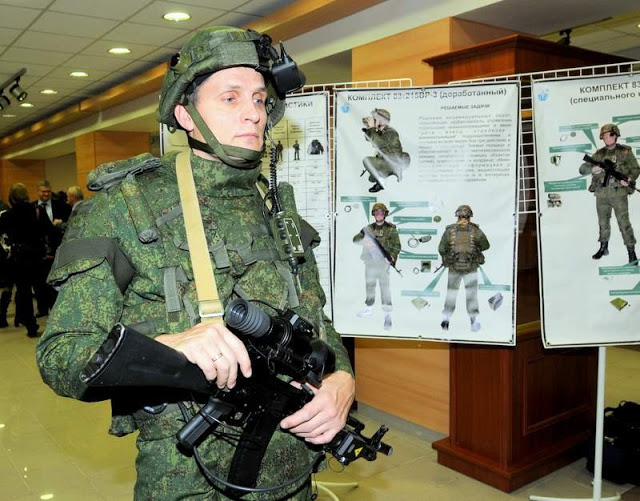Ratnik is a Russian infantry combat system. It is designed to improve the connectivity and combat effectiveness of the Russian army. Improvements include modernized body armor, helmet with special monitor (eye monitor, thermal, night vision monocular, flashlight), systems of communication and special headphones.
The “Strelets” (“Musketeer”) system gives ability of voice and video communication. Also, it includes a GLONASS navigation module, so a squad leader can see location of each soldier on his small, book-sized, computer. With this computer, he also can give orders to his squad, send videos and photos to headquarters. Each soldier has his own tactical computer, but instead of the leader’s computer, this one is smaller, telephone-sized.
“Ratnik” protects almost 90% of soldier’s body. In general, weight of full “Ratnik” equipment with the special thigh and shoulder bulletproof shields is 19-20 kilograms. Basic “Ratnik” (for engineers and medics) weighs 15 kg ( without thigh and shoulder guards).
Serial deliveries and batch production of Ratnik began in the first half of 2015. The Russian military will get about 80,000 sets of the Ratnik-2 “future soldier” gear before the end of 2015
The Ratnik gear comprises more than 40 components, including firearms, body armor, and optical, communication and navigation devices, as well as life support and power supply systems.
Russia is trying to match the US systems for transmitting situational awareness and large scale field coordination to soldiers.
A pair of large-caliber sniper rifles has been added to the new Ratnik combat gear The 12.7 mm 6VM7-1 and the 6VM7 sniper systems, built by the Degtyarev plant in Kovrov, are relatively lightweight (11 kg) and designed in a bullpup (i.e., magazine behind grip/trigger section) configuration. Both have an effective range of 1,500 m and come equipped with a 1-P88-2 variable-range sight and can be fitted with a 1PN139 thermal visor.
Russia is working on third generation Ratnik gear now.
Third generation equipment is looking to include combat exoskeletons.

Brian Wang is a Futurist Thought Leader and a popular Science blogger with 1 million readers per month. His blog Nextbigfuture.com is ranked #1 Science News Blog. It covers many disruptive technology and trends including Space, Robotics, Artificial Intelligence, Medicine, Anti-aging Biotechnology, and Nanotechnology.
Known for identifying cutting edge technologies, he is currently a Co-Founder of a startup and fundraiser for high potential early-stage companies. He is the Head of Research for Allocations for deep technology investments and an Angel Investor at Space Angels.
A frequent speaker at corporations, he has been a TEDx speaker, a Singularity University speaker and guest at numerous interviews for radio and podcasts. He is open to public speaking and advising engagements.








